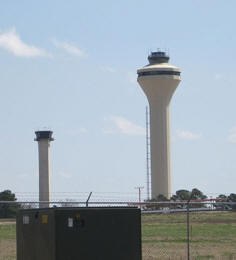|
|||||||||||||||||
|
|
|
|||
|
FAA Dedicated New
Tower And Radar Approach Control At Memphis Intern. Airport By Steve Hall |
||||
 |
October 22, 2011 - Federal Aviation Administration (FAA) Administrator Randy Babbitt on Thursday dedicated the new $72.6 million air traffic control tower and radar approach control at Memphis International Airport. The new tower enables air traffic controllers to continue to provide the safest, most efficient service to both passenger and cargo flights. “We must invest in rebuilding and expanding our nation’s aviation infrastructure so we can remain competitive in our global economy,” said U.S. Secretary of Transportation Ray LaHood. “The American Jobs Act will put construction workers back to work modernizing our nation’s airports and America’s transportation system.” “This tower is a symbol of the FAA’s commitment to aviation safety and modernization of the air traffic control system,” said FAA Administrator Babbitt. “Our future success depends on keeping our airport infrastructure healthy and investing in NextGen so we can make air travel more efficient, dependable and even safer.” |
|||
|
The new 336-foot-tall Memphis air traffic control tower is equipped with state-of-the-art Next Generation Air Transportation System, or NextGen, technology. The 850 square-foot tower cab has enough room to accommodate additional future air traffic control positions. The 24,000-square-foot base building houses training rooms, administrative offices, and an expanded terminal radar approach control (TRACON), with space for future growth. The new facility has the latest seismic, security, and air traffic simulation capabilities.
Memphis
Tower controllers handled 333,647 takeoffs and landings in 2010,
making it the 22nd busiest tower in the country.
Memphis TRACON controllers handled 356,734 instrument
operations (overflights) in 2010, making it the 23rd busiest
TRACON nationwide. At 336 feet, the new tower in Memphis is the third tallest in the United States. It is surpassed only by Atlanta at 398 feet and Orlando at 345 feet. The old tower was commissioned in 1977. In the past 34 years, as Memphis International Airport has grown in size and number of operations, the FAA has added additional tower and radar positions. The facility’s operational growth, addition of new air traffic control technology, and the airport’s additional runways and taxiways made the height and size of the old tower obsolete. A total of 147 FAA employees work at Memphis Tower, 114 in Air Traffic and 33 in Technical Operations. Tech Ops employees install and maintain air traffic control equipment. The construction contract for $52.2 million was awarded in September 2007 to Flintco, Inc. of Memphis. Equipment and installation costs will be $9.3 million and demolition of the old tower cost $11.1 million, for a total of $72.6 million. The new facility has the latest radar, communications and weather technology including: |
||||


